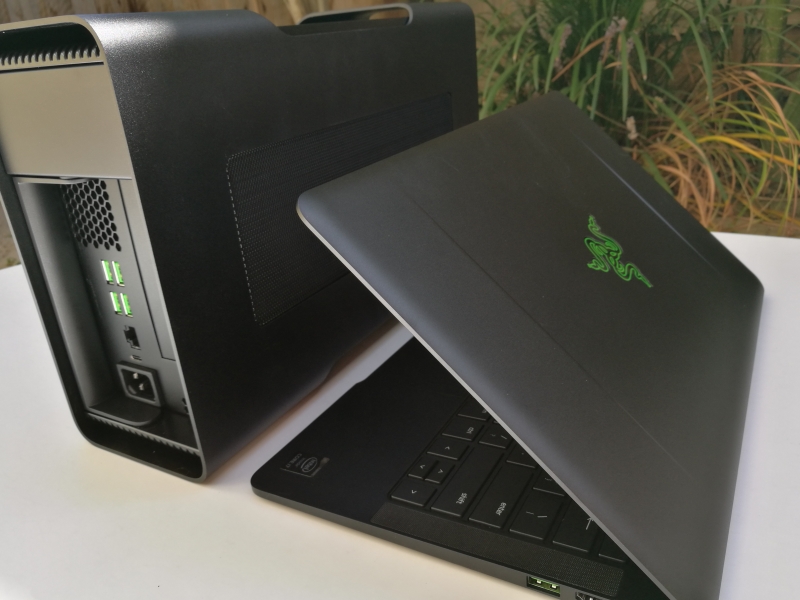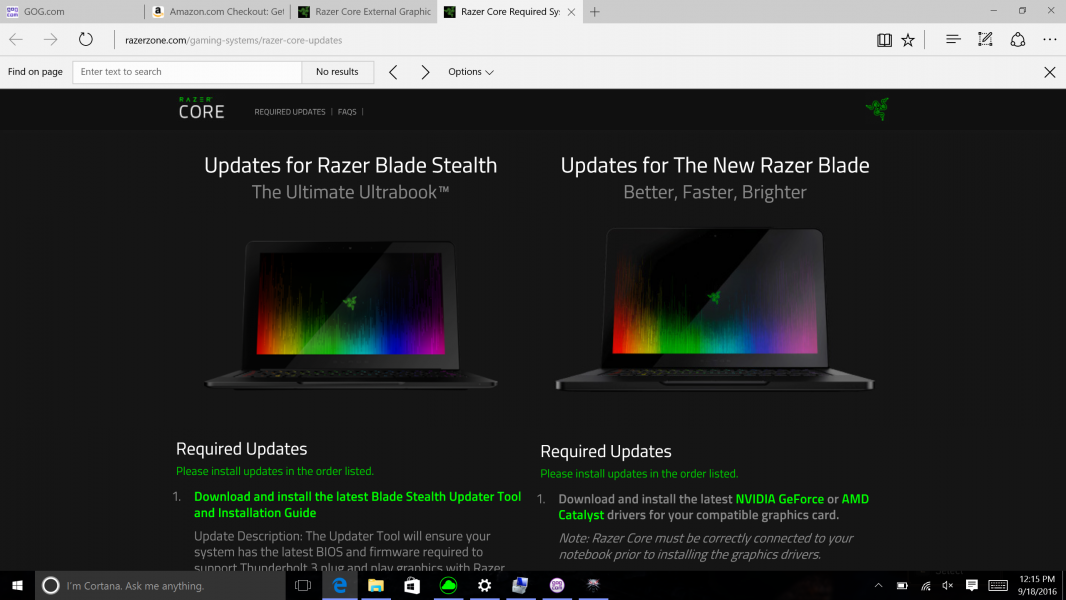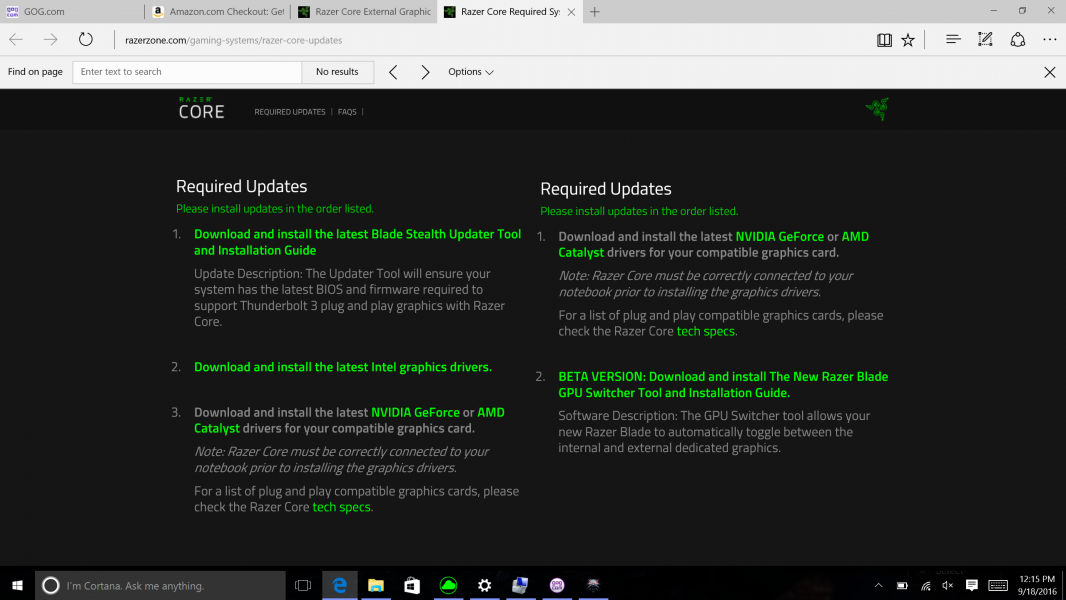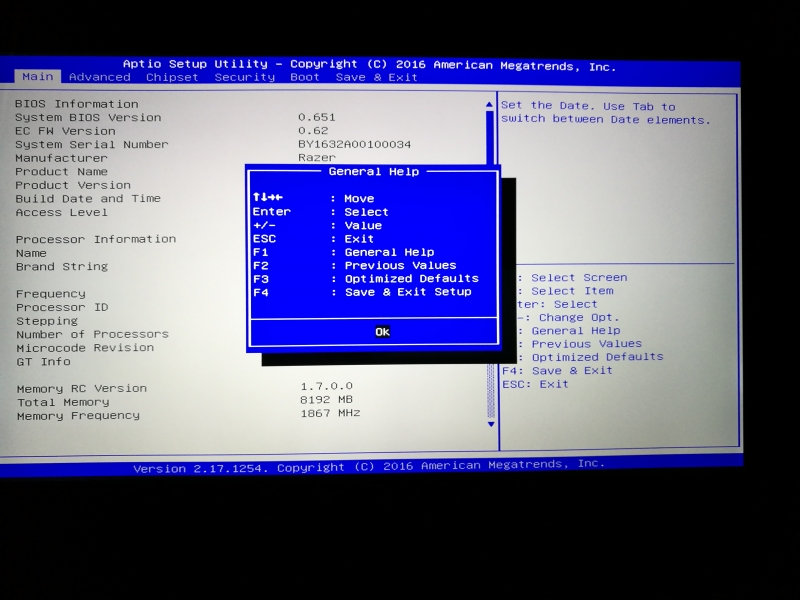The Razer Core enables the ultra portable Razer Blade Stealth gaming notebook to take advantage of a powerful external graphics card placed inside the core. This allows the Razer Blade Stealth to not only enjoy graphics intensive games at higher resolutions and frames per second, but also add USB 3.1 Gen 1 (5 Gb/s), Gigabit Ethernet, as well as whatever video interfaces like HDMI and DisplayPort that is available on the graphics card.
Unfortunately, our experience trying to simply connect the Razer Core to the Razer Blade Stealth was disappointing. Here's what happened.
After connecting the Razer Core to the Razer Blade Stealth with the Thunderbolt 3 cable that came with the Razer Core, we can immediately see that the Razer Core is charging the Razer Blade Stealth. That's the only function that seemed to be working.
In anticipation of experience some awesome graphics performance, we purchased 'The Witcher 3: Wild Hunt' from Amazon and then used the resulting online code to download the game using GOG Galaxy.
Mindful of making sure all the BIOS, firmware, and software drivers were up to date we went to the Razer's Core Update page and followed their instructions.
First we went to the Razer online Support Center's Razer Blade Stealth Updater folder to download the Razer Blade Stealth Updater file.
Once downloaded, we ran the Updater program.
The Blade Stealth Updater program reported that all the software components on the Blade Stealth were up to date.
Next we went to Intel's Support site to download and install the Intel Driver Update Utility.
After installing and launching the Intel Driver Update Utility, we could then update the Intel graphics driver.
After this rather long setup process, the Razer Blade Stealth restarted to finish the installation.
After replugging the Razer Core to the Razer Blade Stealth using the Thunderbolt 3 cable, we could still see that Core was charging the Blade Stealth.
Unfortunately, we could still see there was no Thunderbolt connectivity whatsoever. In the Blade Stealth's Device Manager, no Thunderbolt controller was visible in the PCI Express tree.
Opening up the Thunderbolt Software that is pre-installed in the PC, we could also see no Thunderbolt devices connected.
We again double checked with the Blade Stealth Updater that everything was up to date.
We also went directly to the Razer's online Blade Stealth's Hardware Drivers folder to download, uninstall, and reinstall the Thunderbolt driver.
After uninstalling the Thunderbolt software, we reinstalled it again.
After reinstalling the Thunderbolt Software, for a brief period of time we could actually see the Thunderbolt controller on the Blade Stealth visible in the Attached Thunderbolt Devices window.
We could also see the Thunderbolt controller in the Device Manager.
Unfortunately, just as quickly as it appeared, the Thunderbolt controller disappeared from the Device Manager and Thunderbolt Software's Attached Thunderbolt Devices window.
We were successful connecting other Thunderbolt 3 devices like the Plugable Thunderbolt 3 Dual DisplayPort Adapter to the Razer Blade Stealth so it seemed like the Blade Stealth was behaving correctly. When we tried connecting the Razer Core to other Thunderbolt 3 PC's like the ASUS Q524UQ and Dell XPS 13 9350, we saw the same problem where the other PC's were not recognizing the Thunderbolt link so it seemed like there was a problem with the Core.
At this point, after spending a lot of time on this issue, we tried to contact Razer for support. The only avenue to contact Razer supported seemed to be through submitting a web form online. Phone or even online text chat support would have been useful.
After checking Razer's physical store in San Francisco, it didn't seem they had any person to person technical support there as well.
Within 24 hours after submitting our issue, we received the e-mail below from Razer support asking us to reset everything.
Unfortunately, despite doing these resets, the Razer Core still was unable to the Razer Blade Stealth.
We finally then tried one more thing- switching out the Thunderbolt 3 cable from the one that came with the Razer Core to one that was made by Lintes. This time we had success.
When we later switched back to using the cable that came with the Razer Core, that cable initially worked. But plugging and unplugging the cable several times and waiting for all the devices to correctly enumerate, after the third or fourth time the Razer Core lost enumeration again. Only after unplugging and replugging in the AC power cord to the Razer Core could we get enumeration back, but would have problems again after several plugs and unplugs. When we switched back to the Lintes cable we found the same problem.
It seems like the Razer Core is unable to handle unplugging and plugging from the Razer Blade Stealth in a stable manner which is a problem especially for a dock. If you find yourself in this situation, try to unplug and plug the Razer Core's power cord to get your Thunderbolt connection back.
We asked Razer to exchange the Razer Core for a model that can connect to the Razer Blade Stealth in a more stable manner. The Razer Core was fixed and returned. We then found the Razer Blade Stealth to also have problems connecting to any Thunderbolt peripheral- after a couple rounds of returning the notebook PC to Razer, it was eventually fixed.
In the next review, we set up the Razer Core with the Razer Blade Stealth to plays games leveraging an NVIDIA GPU card inserted into the Core.
 GTrusted
GTrusted




















































































